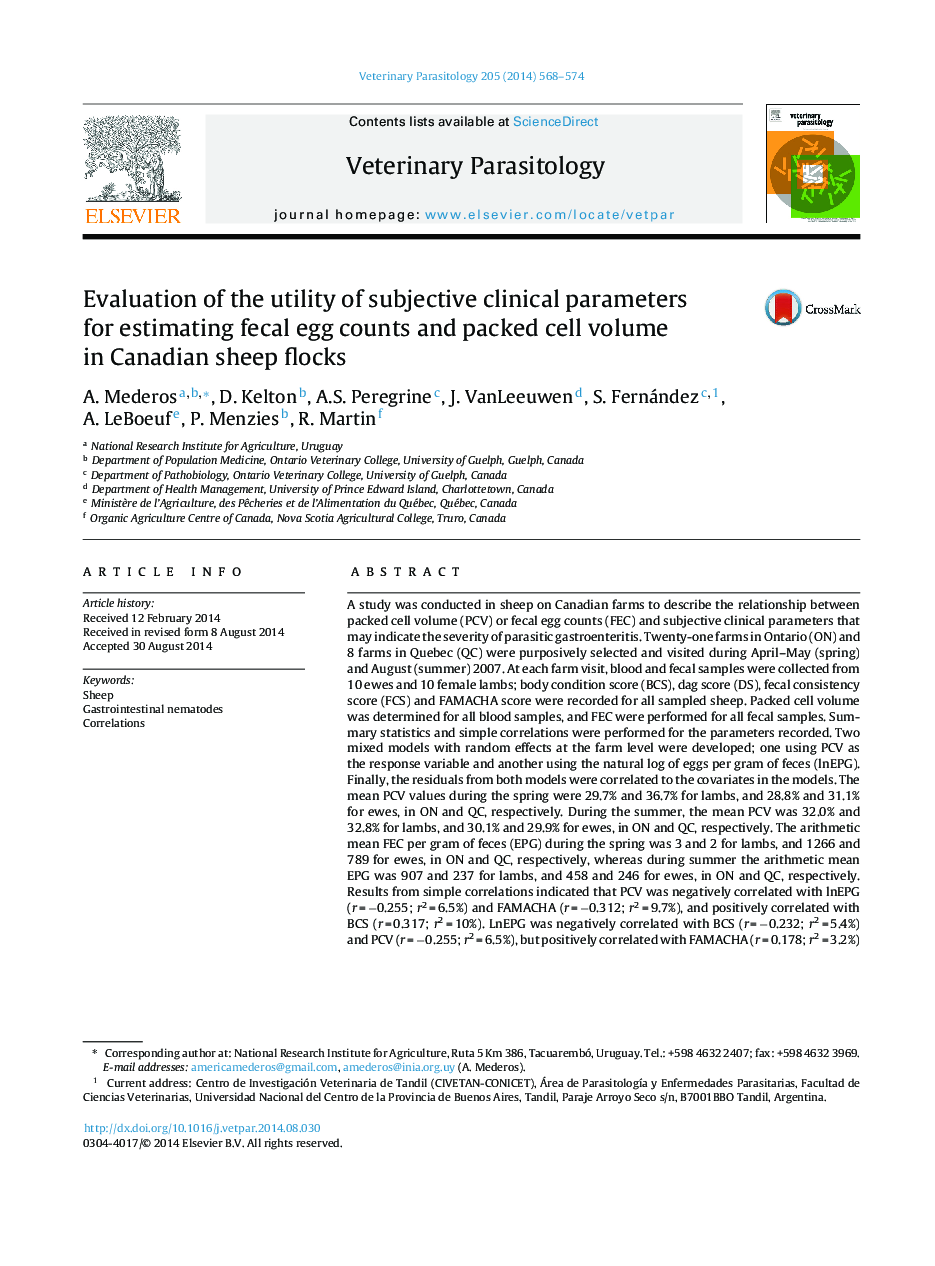| کد مقاله | کد نشریه | سال انتشار | مقاله انگلیسی | نسخه تمام متن |
|---|---|---|---|---|
| 5803069 | 1555680 | 2014 | 7 صفحه PDF | دانلود رایگان |
- We studied clinical parameters to estimate gastrointestinal nematode burden in sheep.
- Mixed linear models with random effects were fitted to correlate the residuals.
- We found poor correlations between fecal egg counts (FEC) and packed cell volume (PCV).
- FAMACHA, body condition and dag score were significantly correlated with PCV or FEC.
- None of the associations were strong enough to accurately estimate PCV or FEC.
A study was conducted in sheep on Canadian farms to describe the relationship between packed cell volume (PCV) or fecal egg counts (FEC) and subjective clinical parameters that may indicate the severity of parasitic gastroenteritis. Twenty-one farms in Ontario (ON) and 8 farms in Quebec (QC) were purposively selected and visited during April-May (spring) and August (summer) 2007. At each farm visit, blood and fecal samples were collected from 10 ewes and 10 female lambs; body condition score (BCS), dag score (DS), fecal consistency score (FCS) and FAMACHA score were recorded for all sampled sheep. Packed cell volume was determined for all blood samples, and FEC were performed for all fecal samples. Summary statistics and simple correlations were performed for the parameters recorded. Two mixed models with random effects at the farm level were developed; one using PCV as the response variable and another using the natural log of eggs per gram of feces (lnEPG). Finally, the residuals from both models were correlated to the covariates in the models. The mean PCV values during the spring were 29.7% and 36.7% for lambs, and 28.8% and 31.1% for ewes, in ON and QC, respectively. During the summer, the mean PCV was 32.0% and 32.8% for lambs, and 30.1% and 29.9% for ewes, in ON and QC, respectively. The arithmetic mean FEC per gram of feces (EPG) during the spring was 3 and 2 for lambs, and 1266 and 789 for ewes, in ON and QC, respectively, whereas during summer the arithmetic mean EPG was 907 and 237 for lambs, and 458 and 246 for ewes, in ON and QC, respectively. Results from simple correlations indicated that PCV was negatively correlated with lnEPG (r = â0.255; r2 = 6.5%) and FAMACHA (r = â0.312; r2 = 9.7%), and positively correlated with BCS (r = 0.317; r2 = 10%). LnEPG was negatively correlated with BCS (r = â0.232; r2 = 5.4%) and PCV (r = â0.255; r2 = 6.5%), but positively correlated with FAMACHA (r = 0.178; r2 = 3.2%) and DS (r = 0.086; r2 = 0.7%). Results from the models indicated that PCV and lnEPG residuals were negatively correlated with FAMACHA, FCS and almost all categories of BCS and DS, although the correlations were very low. The main results from this study suggested that none of the subjective clinical parameters evaluated were highly correlated with PCV or lnEPG and therefore were not good predictors of lnEPG or PCV on the studied farms in Ontario and Quebec.
Journal: Veterinary Parasitology - Volume 205, Issues 3â4, 15 October 2014, Pages 568-574
